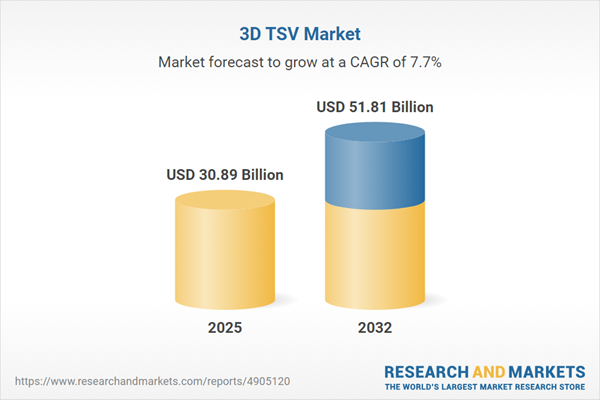Speak directly to the analyst to clarify any post sales queries you may have.
Three dimensional through silicon via (3D TSV) technology is transforming how semiconductors are integrated, offering vertical connections that advance efficiency, performance, and miniaturization. For senior decision-makers, a thorough understanding of the evolving 3D TSV market is critical for shaping strategy, optimizing supply chains, and aligning technology investments in a dynamic sector.
Market Snapshot: Solid Growth Trajectory in 3D TSV Technology
The 3D TSV market is experiencing substantial momentum, expanding from USD 28.68 billion in 2024 to USD 30.89 billion in 2025. Projections show a continued upward path with a CAGR of 7.67%, expected to lead the market to USD 51.81 billion by 2032. This growth is powered by rising demand for advanced system performance, increased adoption of smaller electronic components, and penetration across industries from computing and consumer electronics to automotive manufacturing. The 3D TSV market is also seeing accelerated innovation as companies target faster, more flexible devices and streamline production to address competitive pressures worldwide.
Scope & Segmentation of the 3D TSV Market
- TSV Material Type: Copper and tungsten are the primary materials used, supporting both electrical performance and heat management across intricate semiconductor packaging processes.
- Wafer Size: Market solutions utilize 200 mm and 300 mm wafers, addressing varying production volumes and technology generations within the semiconductor supply chain.
- Packaging Type: Both 2.5D and full 3D packaging are central to current manufacturing, serving different integration and performance needs in chip assembly.
- Application: Key applications include CMOS image sensors, logic units such as CPUs and GPUs, and memory components like DRAM and NAND Flash. Each benefits distinctively from high-density, vertical interconnects.
- End User Industry: The market caters to automotive solutions (including ADAS and infotainment systems), consumer electronics like smartphones and laptops, healthcare diagnostics and imaging applications, and information communication technology used in networking equipment and servers.
- Regional Coverage: Americas comprise markets such as the United States, Canada, and Brazil, while EMEA includes countries like the UK, Germany, and the UAE. The Asia-Pacific region—led by China, Japan, and South Korea—remains a key driver for manufacturing scale and technology deployment.
- Leading Companies: Notable players shaping the market landscape include Taiwan Semiconductor Manufacturing Company Limited, Samsung Electronics Co., Ltd., ASE Technology Holding, SK Hynix Inc., Amkor Technology, EMK Technologies, Yole Group, Powertech Technology, Synopsys, and UTAC Holdings.
Key Takeaways for Senior Decision-Makers
- Through silicon via structures are enabling next-generation architectures by delivering compact, efficient connectivity—driving differentiation and accelerating innovation for system designers.
- Material advancements, notably the effective use of copper and tungsten, are improving both the electrical pathways and thermal performance essential for today’s dense packaging environments.
- The market shift from test-stage adoption to scalable, mainstream production is strengthening industry partnerships among foundries, equipment providers, and end users, establishing long-term supply reliability.
- Sector-specific requirements and end-market expectations influence how organizations integrate TSV—image sensors, memory, and logic modules each require tailored solutions for optimal benefit.
- Regional factors continue to influence industry strategies, with North America focusing on intensive computing applications, Europe emphasizing automotive and industrial electronics, and Asia-Pacific leveraging its manufacturing capabilities for cost and scalability advantages.
Tariff Impact: Navigating Trade Policy Shifts
Recent US trade measures have introduced new tariffs on key semiconductor components, prompting companies to revisit sourcing strategies and adjust cost structures. Organizations are responding by diversifying suppliers, shifting some production to alternative regions, and implementing dual sourcing with process improvements. These adaptive strategies are reinforcing supply chain resilience and decreasing exposure to policy fluctuations, highlighting the value of proactive engagement across the supplier network.
Methodology & Data Sources
This report integrates primary interviews with semiconductor engineers and packaging specialists alongside secondary sources such as technical journals, industry publications, and regulatory documents. Data validation is ensured by cross-verification and expert adjudication, maintaining high standards of analytical accuracy and consistency.
Why This Report Matters
- Delivers actionable, data-driven perspectives for executives pursuing greater supply chain flexibility and enhanced performance via 3D TSV technology.
- Provides clarity on market drivers, sector challenges, and technology trends affecting TSV adoption, enabling strategic planning in a changing market landscape.
- Supports leadership in making technology and sourcing decisions with confidence in the face of shifting competitive and regulatory environments.
Conclusion
3D TSV technology is increasingly central to shaping future semiconductor platforms. By aligning strategies in materials, processes, and sourcing, senior leaders can position their organizations to capitalize on TSV’s integration and performance capabilities.
Additional Product Information:
- Purchase of this report includes 1 year online access with quarterly updates.
- This report can be updated on request. Please contact our Customer Experience team using the Ask a Question widget on our website.
Table of Contents
3. Executive Summary
4. Market Overview
7. Cumulative Impact of Artificial Intelligence 2025
List of Figures
Samples

LOADING...
Companies Mentioned
The key companies profiled in this 3D TSV market report include:- Taiwan Semiconductor Manufacturing Company Limited
- Samsung Electronics Co., Ltd.
- ASE Technology Holding, Co., Ltd.
- SK Hynix Inc.
- Amkor Technology, Inc.
- Yole Group
- EMK Technologies Pte Ltd.
- Powertech Technology Inc.
- Synopsys, Inc.
- UTAC Holdings Ltd.
Table Information
| Report Attribute | Details |
|---|---|
| No. of Pages | 195 |
| Published | October 2025 |
| Forecast Period | 2025 - 2032 |
| Estimated Market Value ( USD | $ 30.89 Billion |
| Forecasted Market Value ( USD | $ 51.81 Billion |
| Compound Annual Growth Rate | 7.6% |
| Regions Covered | Global |
| No. of Companies Mentioned | 11 |









